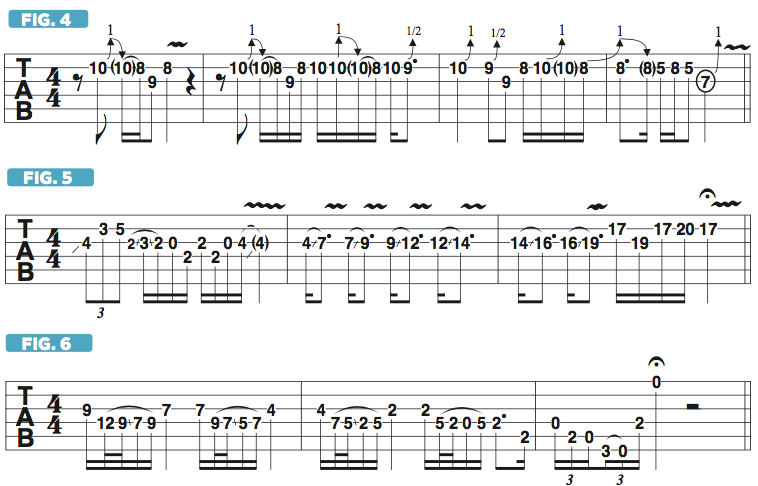More Approaches to Soloing on a Pair of Adjacent Strings
Learn how to solo on the B and G strings, plus how to remain on them while traversing up and down the fretboard.
Last month, I introduced the concept of soloing on a pair of adjacent strings and remaining on them while traversing up and down the fretboard. We began on the B and high E strings, so this month let’s apply the concept to the next lower pair of neighboring strings, the B and G.
Forcing oneself to remain on a pair of strings and shift up and down the fretboard through different positions will result in a variety of otherwise unexpected and fresh-sounding melodic choices. Instead of letting your fingers “do the talking,” you have to listen and then respond accordingly in order to perform improvised lines that have focus, direction and feeling.
FIGURE 1 illustrates the E blues scale (E G A Bb B D) played entirely on the B and G strings, moving in bar 1 from 10th position down to eighth, and then down to fifth position in bar 2, at which point I switch to the “B.B. box” concept for soloing, so named for blues guitar great B.B. King. The B.B. box is built from a combination of the major and minor pentatonic scales; in E, the notes used are, in ascending order, C# E F# G G#. Alternating between the darker sound of the blues scale and the lighter sound of the parallel major pentatonic scale (in this case, E major pentatonic: E F# G# B C#) is an essential element of blues guitar, characteristic of the playing of Eric Clapton, Jimi Hendrix, Buddy Guy, Otis Rush and many others.
FIGURE 2 is a two-bar improvised line that connects these two melodic positions: in bar 1, on beats one and two, the line sits squarely on E minor pentatonic (E G A B D), but at beat three, I shift down to the B.B. box, to attain a sweeter, E major pentatonic sound. FIGURE 3 offers a slightly more complex example of moving from the higher position to the lower one while remaining on the same pair of strings.

Clapton often took this approach with Cream, for which he would start with a basic melodic idea (see FIGURE 4, bar 1) and then elaborate on it (bars 2-4). The concept of theme and development is one that can be found in every style of music, and it is always at the heart of a great guitar solo.
FIGURE 5 begins in third position, but in bar 2, I continually slide up the G string to present a very specific melodic idea. You’ll hear Clapton employ this same technique on the studio version of Cream’s “I’m So Glad,” and Buddy Guy uses a similar approach for his solo lines on Muddy Water’s “Same Thing.”
Let’s wrap up this lesson by moving down to the next pair of adjacent strings, the G and D. In FIGURE 6, I take a specific melodic phrase that moves between two scale positions and then continually recast it to the next lower position. I think of each series of notes as a “template” that one drops down onto the fretboard, resulting in varying melodic shapes that may not have occurred to me to play without implementing this specific and unusual approach to improvising.
All the latest guitar news, interviews, lessons, reviews, deals and more, direct to your inbox!

Guitar World Associate Editor Andy Aledort is recognized worldwide for his vast contributions to guitar instruction, via his many best-selling instructional DVDs, transcription books and online lessons. Andy is a regular contributor to Guitar World and Truefire, and has toured with Dickey Betts of the Allman Brothers, as well as participating in several Jimi Hendrix Tribute Tours.

